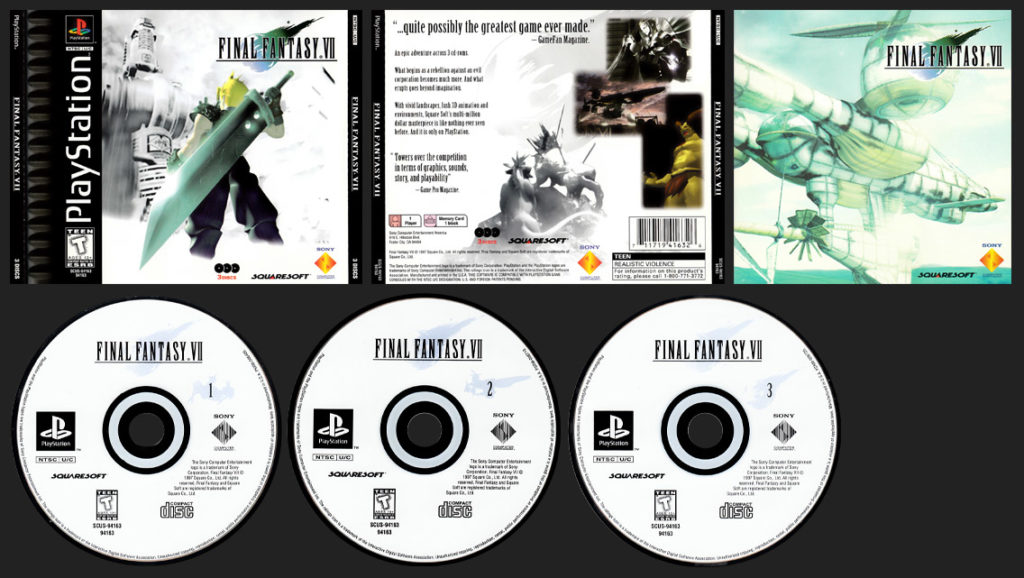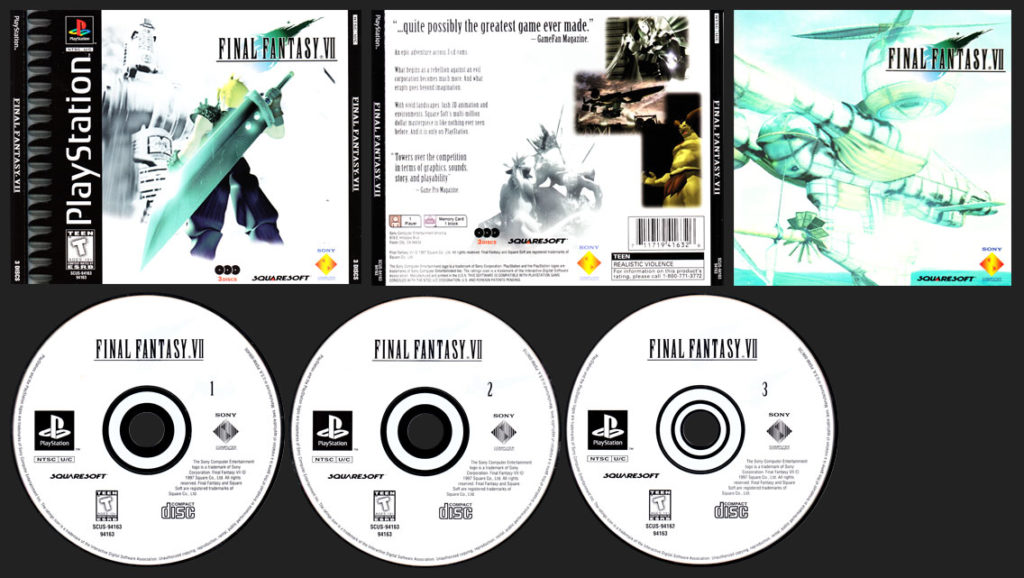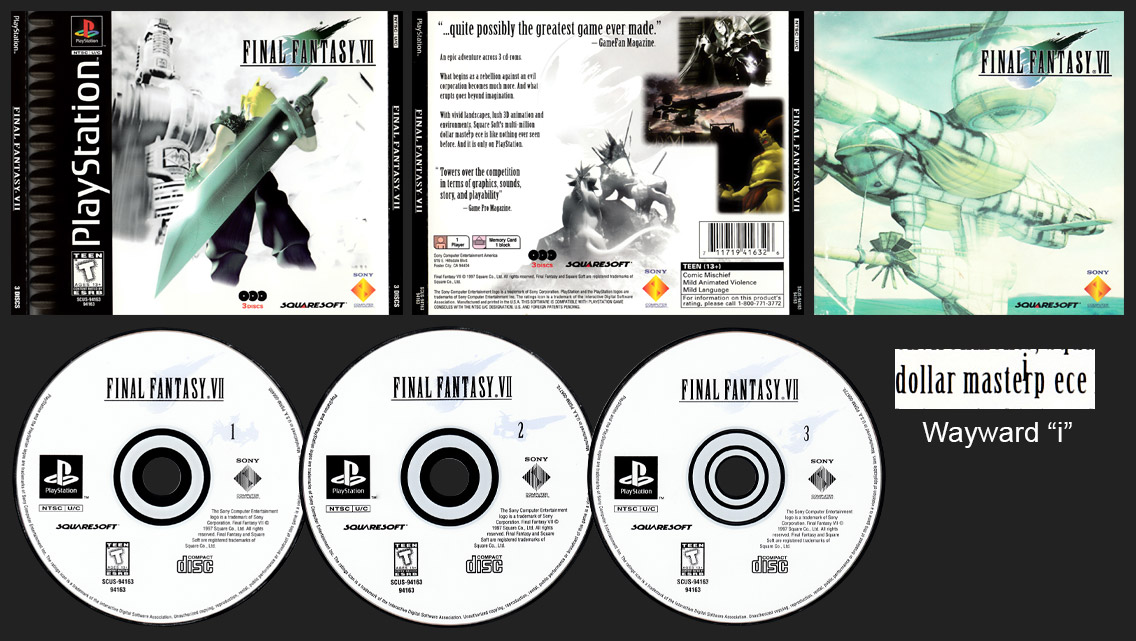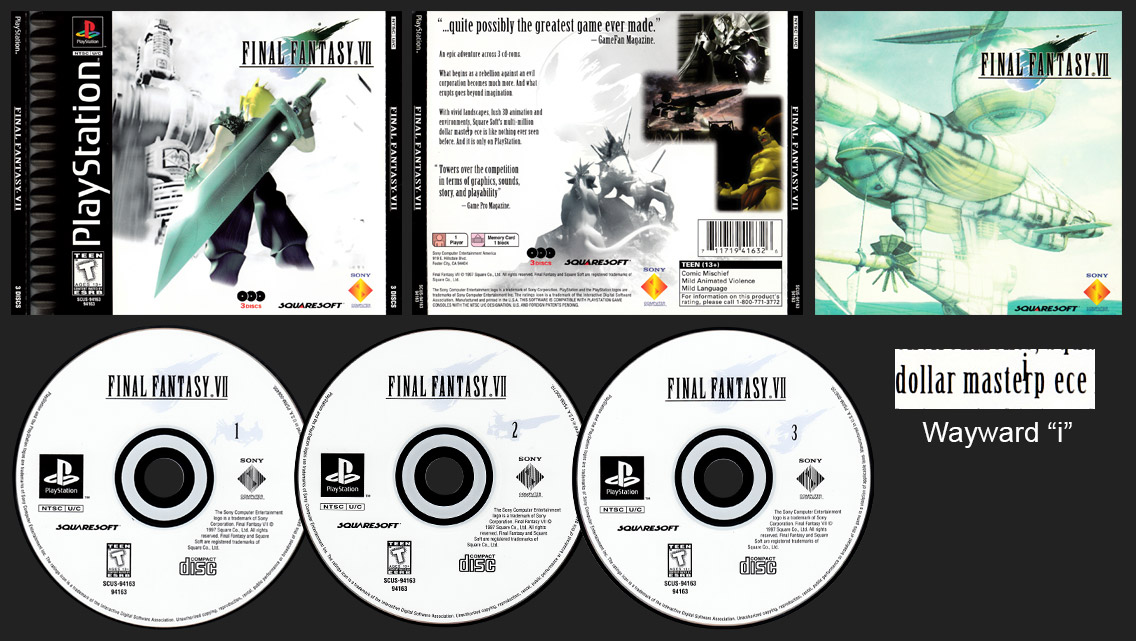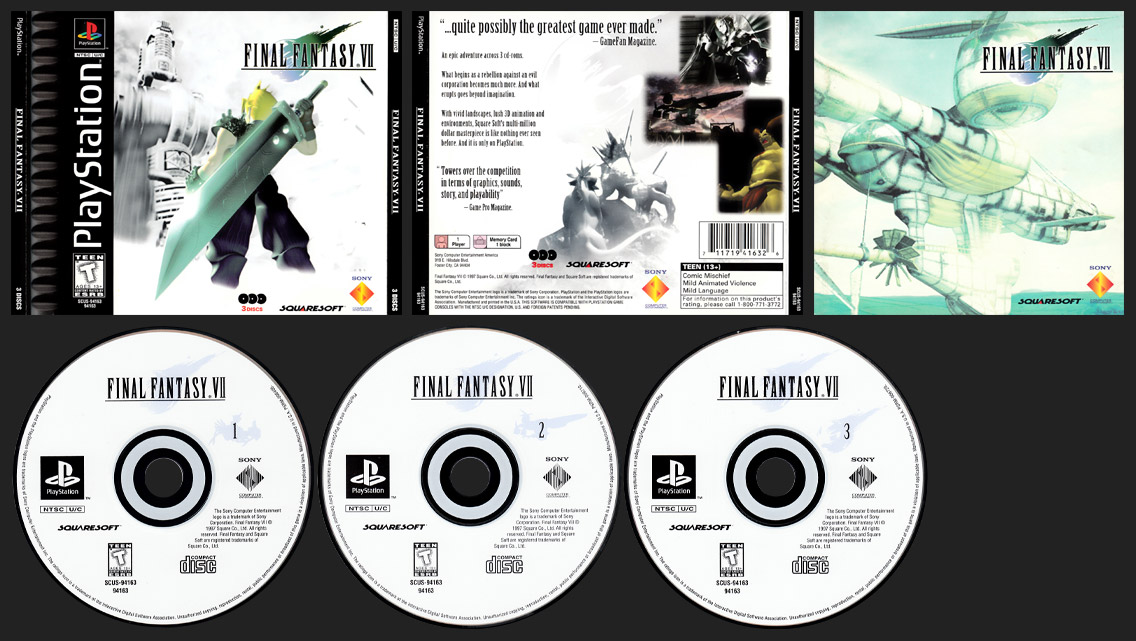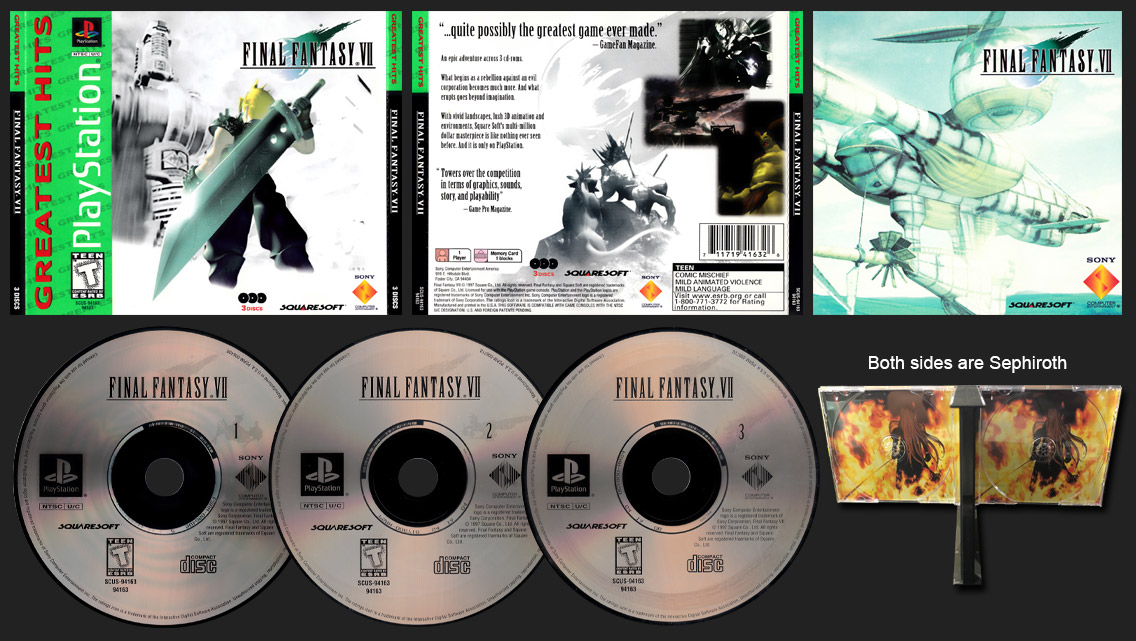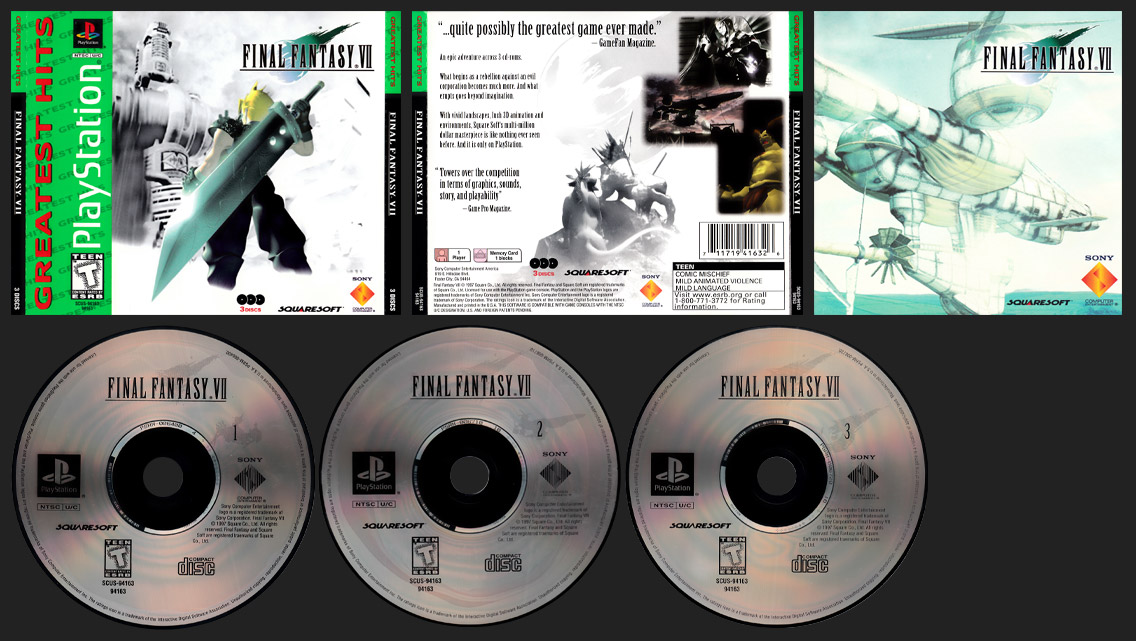| Genre: Role Playing Game |
CDs: 3 |
|---|---|
| Publisher: Sony Computer Entertainment |
Released: September 3, 1997 |
| Developer: Squaresoft |
UPC: 7 11719 41632 6 |
| Sony ID: SCUS-94163 |
PSRM: 006400, 006710, 006720 |
| Players: 1 Player |
Memory: 1 Block |
| Accessories: None |
|
| ESRB: Teen – Realistic Violence |
|
| Box Copy:
“…quite possibly the greatest game ever made.” – GameFan Magazine An Epic Adventure across 3 CD-ROMs. What begins as a rebellion against an evil corporation becomes much more. And what erupts goes beyond imagination. With vivid landscapes, lush 3D animation, and environments, Square Soft’s multi-million dollar masterpiece is like nothing ever seen before. And it is only on PlayStation. “Towers over the competition in terms of graphics, sounds, story, and playability.” – GamePro Magazine |
|
Variants
Final Fantasy VII is one of the most revered, loved, and appreciated games in history. It’s also one of the most incorrectly printed games in history. It can wear many hats.
We start with THIS calamity. Here’s the Disc 3, 2-Ring Hub version in the Realistic Violence case!
These aren’t two different copies bashed together. Multiple eBay auctions confirmed this release. Considering there are no 2-ring versions of Discs 1 and 2, Sony must have maxed out a production facility and had a 2nd one print up the third disc.
Thanks to viewer Nathan H. for discovering this chaos.
However, the above variant has created a chain reaction to everything else in this list. I have re-arranged the order to how it theoretically should be.
So Sony and Squaresoft have the ESRB take a fresh look and instead of the previous descriptor, we get “Comic Mischief, Mild Animated Violence, and Mild Language.” Cool! We’re all…’ squared away’ if you will…except…what the hell happened to the ‘i’ in ‘masterpiece’?!
Yep. As a graphic designer having had the privilege of staring at this stupid wayward letter for two decades, I have tried to figure out how this happened. Letters are not individually controlled when typed into computer art programs. It’s still one full word to manipulate, and knowing it’s correct in the Realistic Violence version…this is just insanity. I just can’t.
Here’s where things get hairy – *really* hairy. With the above 2-ring 3rd disc confirmed by more than 5 copies of the game, this variant below now comes into question. Either Sony had more discs to go through from the above print run with the new inserts, or it’s a mismatch. So far, it’s been impossible to prove due to how little the 2-ring set comes up in searches.
The good old masterpiece variant returns us to normal with the three standard discs.
In full disclosure, I don’t know where this one fits in. The Masterpiece goof is gone, and we have the three ESRB descriptors. It’s actually…fine. So it either came after the Realistic Violence print as a valid update, or it’s the correction of the masterpiece goof.
When it came time for the game to go full Greatest Hits, which it probably hit on Day 1, Sony must have had a lot of leftover front inserts. The game’s first flirt with going green was only halfway there. Everything but the front insert was the proper Greatest Hits coloring and design. This 50/50 variant was confirmed by two sealed copies on eBay.
Also of note is the ERSB info. It still has the same descriptors, but the font is off – it’s too big for the space provided within the rectangle shapes. This oddity would last through the Greatest Hits run.
Also – all of the silver top Greatest Hits discs have the word “Trademarks” spelled as “Traemarks” because there is no god.
Also, the Memory Card Icon now reads “1 Blocks”. BECAUSE WHY NOT?!

50/50 Variant – Front Insert is the Black Label release, rest of packaging and discs are Greatest Hits.
Next up we have the version of Final Fantasy VII only a Jenova could love – it’s double the Sephiroth, baby! That’s right, in updating the front artwork to finally be 100% Greatest Hits, the layout artist assigned the wrong inner artwork to the back of the panel. It should be the left half of the airship image with Aerith.
That means Sephiroth removed Aerith from the game case…it’s like a spoiler!
Still no fix for the Memory Card Icon.
Finally…blessedly…I hope, is the last variant for the game. The Greatest Hits printing that once again returns everything to normal aside from not fixing the ESRB font issue. Still “1 Blocks” on the Memory Card, though.
Misprints
But wait, there’s more! Head over to friend of the site I.Am.Error who tracks factory production misprints across all systems. Among the tracked issues include:
- No silk screening on Disc 3
- Disc Two has wrong Number Icon
- Multiple Covers on the manual
- An upside-down page stapled in
- Folded pages caught in the trimmer
- Disc damaged in shipping
- A copy whose Disc 3 plays Spongebob!
- Missing artwork on Disc 1
- …and more
Review
- There is no review for this game yet.
The Good
- No Review
- No Review
- No Review
The Bad
- No Review
- No Review
- No Review
Final Score: NA – No Review
Summary Text
Screenshots
- There are no screenshots for this game yet.
Videos
Final Fantasy VII made GameRaveTV’s Top 10 Games of 1997…but where in the list did it make it?

Trivia
- This was the first Final Fantasy game to have sequels on multiple media formats. It gained the animated movie Advent Children, a cell phone game in Japan based on the Turks, a PS2 game featuring Vincent called Dirge of Cerberus, and then the PSP game Crisis Core.
- Final Fantasy VII uses a unique character portrait for the Save Data image – each of the 15 blocks on a Memory Card will have a specific in-game character.
- With a cheat Device (GameShark, Action Replay), it is possible to access a debug room built into the game.
- It is possible to acquire a certain character’s Final Attack even after they have been removed from the story.
- The US version, aside from having some game play corrections also included two new huge enemies to deal with; Ruby and Emerald. Square would later rerelease the American version in Japan as the ‘International Version’.
- One of the towns has a glitch where the clipping is off – if you can move Cloud just right, you’ll actually walk up the building, not to it.
- Would be the first time series illustrator Yoshitaka Amano’s artwork would not be used for principle game usage.
- Continued the tradition of naming the lead character after a watery element; Locke (FFVI), Cloud, and Squall (FFVIII).
- Biggs, Wedge, and Cid are all recurring characters, and yes, the first two are in reference to Star Wars.






